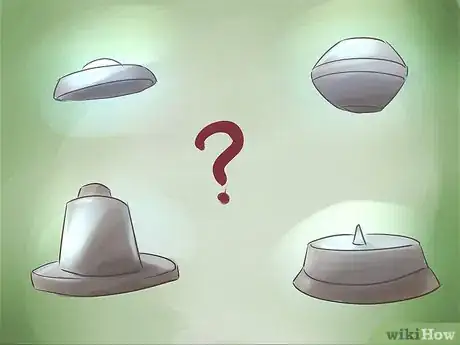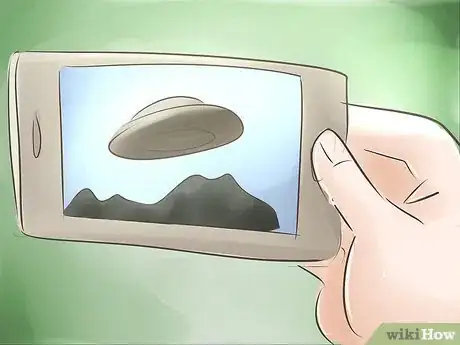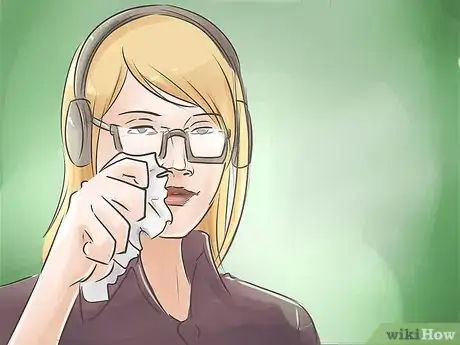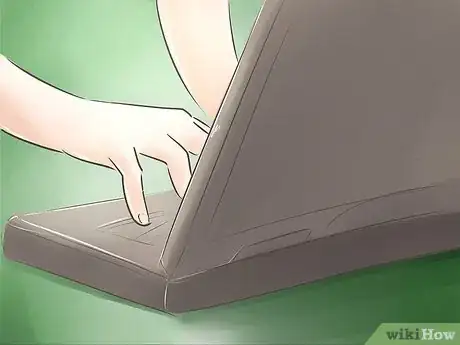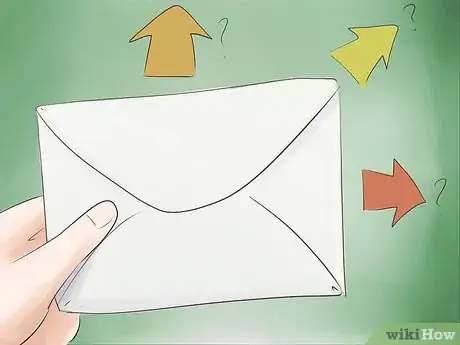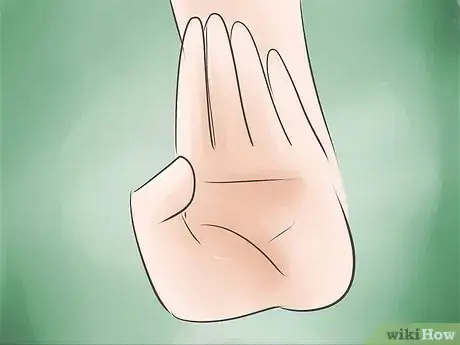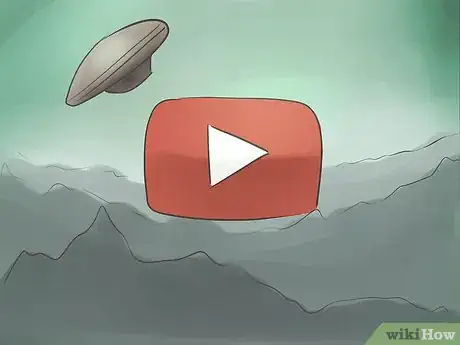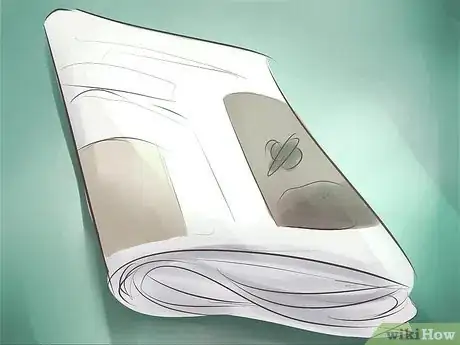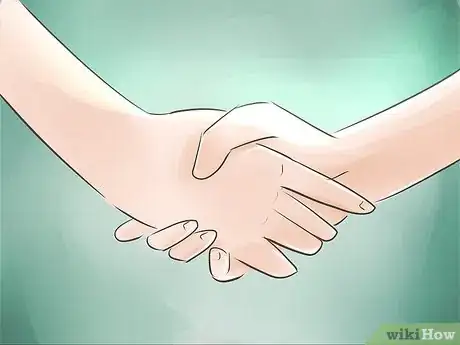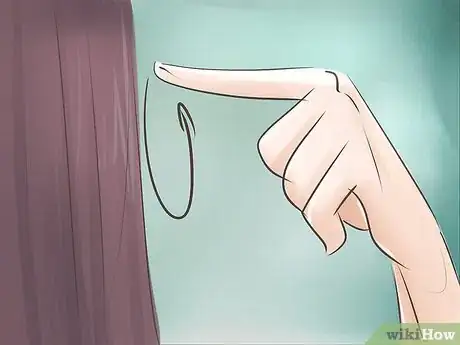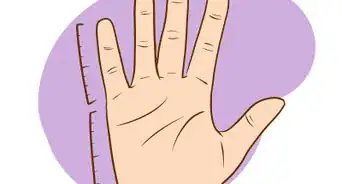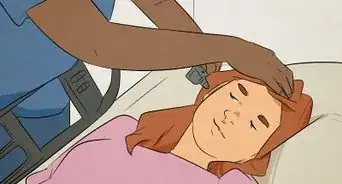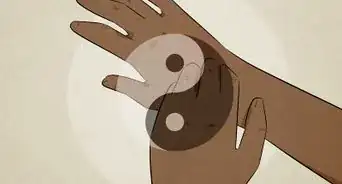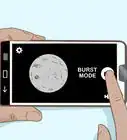X
wikiHow is a “wiki,” similar to Wikipedia, which means that many of our articles are co-written by multiple authors. To create this article, 49 people, some anonymous, worked to edit and improve it over time.
This article has been viewed 119,086 times.
Learn more...
Unidentified Flying Objects (UFOs) are of unknown origin and lack identification. If you've seen one, you may have some information the right authorities would find very interesting. You simply need to turn your experience into a cohesive retelling and deliver it to the right people. If it's convincing enough, you may even hear back. So grab your pen and paper – you've got some details to hash out.
Steps
Part 1
Part 1 of 3:
Forming a Convincing Report
-
1Immediately write down the basics of your experience. Regardless of where you file your report, you need the same basic set-up. It’s best to do this immediately after the sighting so everything is fresh in your head. When it’s fresh, it’s more likely to be accurate. You'll use this information to file a report to specific agencies. Here's what to start with:
- Number of witnesses (to be valid, there needs to be at least 1 other person)
- Time
- Location (if you live next to an Air Force base or other similar area, your report may be discarded)
- Number of objects seen
- Do ‘’not’’ include your personal information in the body of the report. It will have to be removed later.
-
2Include as many details about the object(s) as possible. The more details you have, the more convincing your story will be (or the easier it will be to determine if it’s something else). Think back to experience. These are the aspects you should cover:
- Lights (How many were there? Were they flashing or solid?)
- Color (Did the color ever change?)
- Brightness (Compare it to another object, if possible)
- Motion (How fast did it go? Did it move up and down? Back and forth? Smoothly or erratically?)
- Behavior (Did the object move or land, emit lights, sounds, or other objects?)
- Interactions with space (Did it engage with other aircraft in the vicinity, produce electrical or magnetic effects, such as a car engine stopping?)
- Trail, haze, etc. (Was there an aura or haze around the object, any cloud or smoke trails from the object?)
Advertisement -
3Note their size and how far away the objects likely were. Think of holding up an object at arm’s length to block the view of the UFO.[1] Would you need a dime? A cookie? A plate? Something in between? This may be about as close as you can get.
- Think of the other objects around to determine how far away it was. Was it well above the trees? Hills? Power lines? Satellite towers? This can help you assess it's apparent distance.
-
4Include details on the shape of the craft. There are a few common standards currently known – does your experience fall in line with any of these shapes?
- Saucer: there are three varieties – domed (stereotypical), lenticular (pistachio-shaped), and lenticular with dome
- Hat: there are three varieties – conical hat, double hat, and flat top straw hat
- Sphere: a standard circular shape
- Saturn: in the shape of the planet, as if the object has rings
- Ellipsoidal: egg-shaped when hovering, football-shaped while flying
- Cylindrical: this object looks like a giant cigar
- Dirigible: shaped like a pointy bullet; generally followed by a luminous plume
- Triangle/boomerang: wedge-shaped or v-shaped, like a boomerang
-
5Note the weather at the time of the sighting. The better the weather (fewer clouds, no rain, etc.) the more reliable your story will be and the harder it will be to argue you didn't see what you saw. However, that being said – don't be tempted to lie if it was bad; it's quite easy to find out what the weather actually was that day if need be.
- If it was cloudy or rainy, explain how that affected your vision. Did it obscure anything, even if just partly, from view? Did anything change as the clouds parted or as the rain lifted? Could anything you saw be due to visual distortion from clouds or other natural phenomena?
-
6Include any pictures or video. One of the most effective ways to make your sighting convincing is to include pictures or video – good pictures or video, that is. Don’t bother fabricating something – UFO hoaxes have been around long enough that most can be debunked.
- The best photos aren’t digital. In fact, negatives (on tangible film) are best to prove it hasn’t been tampered with. If it is digital, don’t even think about even so much as resizing it. If it’s been changed from its original form even in the minutest detail, it might get thrown out.
- The best videos have other objects in them for reference and are stationary, so you can see the UFO’s movement, instead of a video that’s panning along with them.
-
7Take note of any impediments you were facing at the time. Were your senses impaired or impeded? These may be similar to points a law enforcement agent would cover. Think of the following details (and be honest):
- Objects between you and the UFO that obscured your view
- If you were wearing contacts or glasses at the time of the sighting
- If you were wearing headphones or anything to impair or prevent your hearing
- If you had a cold or anything preventing your olfactory sense from working properly
- If you were taking prescription drugs, or under the influence of alcohol or other drugs
-
8Write it all together in a cohesive, engaging report. Break it up into paragraphs to make it easy to read. Include any specific knowledge you have from your background that aids the story (for example, if you’re a pilot or have flight/mechanical training).
- It doesn't have to be fancy, but it should be typed up (you'll likely submit it online, so you can just copy and paste it over) and spell-checked. The better it is constructed, the more it will be taken seriously.
- Include a drawing of the UFO. Do your best to show relative size, shape, lights, etc.
Advertisement
Part 2
Part 2 of 3:
Filing Your Report
-
1Choose which agencies to report your sighting to. There's a lot of junk out there online, but there are a few reputable sources. A UFO witness should report a sighting to the following reliable organizations:
-
2Fill out their form to the best of your ability. Each website has it's own form to fill out, but they are all essentially the same – the details you constructed together about your experience. Your personal information shouldn’t be in the actual report; it should be in the form on the website (or given to the operator on a hotline).
- The additional questions will vary from your age and background to your beliefs and your habits prior to that night. It’s all with the purpose of weeding out the people that are mistaken or trying to start a hoax.
- You are completely welcome to file a report with every agency. In fact, it may not be a bad idea. The more resources you tap into, the more likely you are to get results.
-
3Be ready for further questioning or a request of evidence. If your report is valid and intriguing, you may be requested for interviews. If the process continues on, your camera may be requested and you may even be asked to go under oath. This type of thing is taken very seriously; if you’re just having fun, you will be found out.
- If you prefer to remain anonymous, most (if not all) forms can accommodate you. This will not affect how your report is processed. Only in incredibly rare situations will you be asked to name yourself (if you have undoubtable footage, for example).
-
4Never pay anyone to exhibit your experience. There are tons of websites out there that are scams. If you have a true experience, only go to reputable sources. Do your research beforehand and never have anyone “sell your story” for you. It’s yours. You get to do with it as you please.
Advertisement
Part 3
Part 3 of 3:
Getting Wider Coverage
-
1Put the video up on YouTube. There are already thousands of UFO videos on YouTube, but only the good ones become popular. If you have a good video, put it up! It may go viral before you even know it.
- Ignore the comments. YouTube is infamous for people using it as a platform to be disparaging and ridiculous. For every person that is negative, there's someone else who finds your video fascinating.
-
2Contact your local TV stations. If you have good pictures or video and some particularly interesting details you could offer the general populace, contact your local TV station for news coverage. It's possible other people had the same experience. Some may need someone else to speak up for them and convince them they saw what they think they saw.
- Of course, only do this if you're comfortable going in front of the camera and being a local celebrity. Alternatively, you could choose to remain anonymous in this realm as well.
-
3Report it to general media outlets. In addition to TV, there's also newspapers, magazines, and radio. It doesn't have to be local either; nowadays, all of us live in a global village connected by the Internet. Contact a few blogs or websites devoted to reports and add your experience to their archives. Every detail gets us closer to the truth.
- There are hundreds of organizations out there (ranging from the small and silly to the large and serious) looking for more data to prove that we're not alone. Just make sure in doing this that you're working with people you can trust. Never give out any of your personal information that could compromise your identity.
-
4Join a local UFO organization. Many big cities (and some smaller ones) have groups of people dedicated to proving or debunking UFO stories. Some take the gig very seriously and for others it's just a way to kill time after work. Either way, it'll be a great method to meet with others who have likely had similar experiences and who can help you sort out what you saw.
- They can also point you in the right direction of who you should talk to to get your voice heard. These organizations sometimes have more credibility that a single individual can have and therefore may receive more positive, immediate reception.
-
5Be prepared for naysayers. When the topic of anything supernatural comes up, people are always on both sides of the fence. There will be people who hear your story and deem you certifiably crazy, and that's fine. There will also be people who are inspired and wish they'd have their own experience. Don't let anyone's opinion get to you. It doesn't really matter what they think anyway.
- The bigger you go (TV, YouTube, etc.) the more naysayers there will be. In certain situations, there may be a backlash. If you're concerned about this, keep your name out of the equation. However, most cases don't receive enough publicity for this to become an issue.
Advertisement
Community Q&A
-
QuestionWhat should I do if people say that it might have been something else or that I was imagining it?
 Community AnswerShow any proof you have.
Community AnswerShow any proof you have. -
QuestionWhat should I say if people ask me whether I believe in aliens and UFOs?
 Community AnswerTell them what you thought before the sighting and what you believe after the sighting.
Community AnswerTell them what you thought before the sighting and what you believe after the sighting. -
QuestionWhat do I make of two strange green objects appearing in my film of a lightning storm in Florida?
 Community AnswerSearch the internet for any other videos of what you saw. There could be another angle to the situation.
Community AnswerSearch the internet for any other videos of what you saw. There could be another angle to the situation.
Advertisement
Warnings
- Use discretion when discussing a UFO sighting because of the social stigmas applied to the topic of UFOs.⧼thumbs_response⧽
- If you were smoking, drinking alcohol or on drugs or medication at the time of the incident, this may reduce the credibility of your report.⧼thumbs_response⧽
Advertisement
References
About This Article
Advertisement



